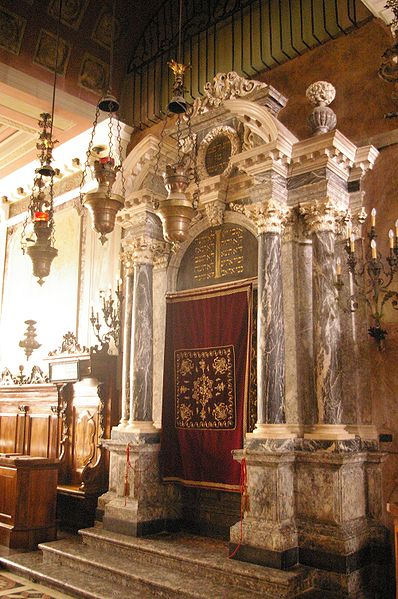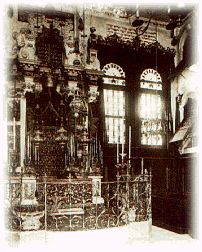| |
JEWISH AND KOSHER ITALY:
PADUA SYNAGOGUE

The Padua Synagogue. Built in 1584
The Padua
Synagogue
Via San Martino e Solferino 13
Padua, Veneto, Italy
Tel: 049-875-1106 ?
Email: cebra.pd@tin.it
?
Rabbi: Aharon Locci
Nusach: Italian
Contact: Raffaele D'Angeli
Tel: 049-871-4999 ?
Synagogue open for Shabbat
Services. Closed during weekdays.
The Jewish Museum next to the
synagogue open on Fridays and Sundays.
Last updated: August 26, 2015
By: Penina Elbaz
peninalbz@gmail.com
Please update us! |

|
--
פדובה - כללי
Padua - Klali
|
|
עיר בצפון איטליה, נמצאת בחבל ונטו. שוכנת על נהר
באקליונה. פדובה היא מרכז מסחרי ותעשייתי חשוב ובה מפעלים לייצור
מכונות, כימיכלים ומוצרי טכסטיל. היא מפורסמת באתריה ובנייניה
ההסטוריים ומושכת תיירים רבים. אוניברסיטת פדואה נוסדה בשנת 1222 והיא
מהעתיקות באיטליה
|
שרידי יישוב מהתקופה הנאוליתית ומתקופת הברונזה
נתגלו בסביבות פדובה. את העיר יסדו כנראה הונטים. היא היתה בעלת ברית
משגשגת של הרומאים. ב 49 לפסה"נ קיבלה את אזרחות רומא, נקראה:
מוניסיפום פאטאויום, והתפרסמה כעיר מולדתו של טיטוס ליויוס. עם פלישת
הברברים ירדה מגדולתה. בתקופת האוטונים החלה שוב להתפתח, ב 1176 השתתפה
בליגה הלומברדית נגד פרידריך ברברוסה והיתה למעצמה כלכלית ופוליטית.
במאות 13 - 14 שלטה על הערים השכנות וינצ'נצ'ה, בסנו ופלטרה ותכופות
התנגשה עם וונציה וורונה ועם משפחת אסטה. ב 1237 השתלט עליה אזלינו, ב
1318 - 1406 שלטו בה בני משפחת קרארה וב 1406 - 1797 היתה בידי ונציה.
בשלטון ונציה פרחה פדובה. פעלו בה הציירים דונטלו ומנטניה ואוניברסיטת
פדואה היתה מרכז להומניזם. בשנים 1815 - 1866 היתה בשלטון אוסטריה
ואח"כ סופחה לאיטליה
|
|
עברה המפואר של פדואה באמנות משתקף בבנייניה, ביצירות
האמנות הרבות המעטרות אותה ובאוסף הציורים שבמוזיאון המקומי. מהתקופה
הרומית שרדו מספר יצירות פיסול ואדריכלות, אך מירב ומיטב היצירות
המצויות בה הן מיה"ב המאוחרים ואילך. בארמון שבלב העיר, פאלאציו דה לה
ראג'יוני, שבנייתו התחילה ב 1218 והושלמו ב 1306, פרסקים מן המאה ה 14.
פרסקים של ג'וטו מעטרים את קאפלת סקרובניי. בקאפלה אובטארי שבכנסיית
ארמיטאני שירידים מציורי הפרסקו של מנטניה ובני דורו. שפע של אוצרות
אמנות, ציורים ופסלים, ממלאים את הכנסיה הראשית של העיר, כנסיית
אנטוניו הקדוש שבנייתה התחילה ב 1232 והושלמה במאה ה14, פסלי המזבח
הראשי של דונטלו, פסלי הקבורה של אנטוניו הקדוש, הפרסקים של אלטיקירו.
לפני בניין הכנסייה מוצס פסל הפרש של הקונדוטירה גאטאמלאטה, יצירת
המופת של דונאטלו. השפעתה של אסכולת הציור שנתגבשה בפדואה במאה ה 15
ניכרה בצפון איטליה ואף בגרמניה
|
פדובה ויהודים
Padua
Veyehudim
|
|
בנקאים יהודיים הגיעו לפדואה במחצית השנייה של המאה ה
14. בחסות בית קרארה גדלה הקהילה ונודעה בעושרה. אולם, משבאה פדובה תחת
שלטון ונציה, איימה על היהודים גזרת גירוש. ב 1456 גורשו הבנקאים
היהודים מן העיר בהשפעת המטיף קפיסטרנו וחסידיואך יתר בני הקהילה נשארו.
ב 1483 שוב התירו ליהודים לעסוק בהלוואות. בעקבות
עלילת
הדם בטרנטו, 1475, התפשטו הפרעות גם לפדובה ונישנו שוב ב 1491
בהשפעת ההסתה של המטיף ברנרדינו דה פלטרה. ב 1492 הגיעו לפדואה ממגורשי
ספרד. הקהילה התחזקה והיו בה שלוש עדות, איטלקית, גרמנית וספרדית. ב
1547 סגרו השלטונות את הבנקים היהודים כדי למנוע התחרות בבנק הנוצרי
מונטה די פייטה. היהודיפ פנו בהצלחה למסחר ביהלומים, בבגדים ובאריגים
|
יהודי פדובה ידעו קשיים רבים, ביניהם: גטו יהודי
הוקם ב 1601 ליד ביהכ"נ. עד 1715 נאלצו היהודים להקשיב להטפות נגדם
בכנסיות. ב 1556 נשרפו ליד בניין המועצה ספרי תלמוד וספרים עבריים
אחרים. בכל זאת נשארה פדואה מרכז חשוב ללימודי היהדות בגלל הישיבות
הגדולות והאישים שעמדו בראשן, כמו מינץ, קצנלבוגן, וכן מפני שיהודים
נמשכו מכל קצווי אירופה ללמוד רפואה באוניברסיטה המקומית. ב 1630 -
1631 מתו ממגיפה 421 מתוך 721 יהודי פדובה. באותה עת התפרנסות רוב
יהודי פדובה מתעשיית המשי. ב 1684, משנפוצה השמועה שהיהודים סייעו
לתורכים בבודה נגד צבאות אוסטריה וונציה, שדד ההמון את הגטו. ב 1797
העניק השלטון הצרפתי אמנציפציה ליהודים ושערי הגטו נפרצו, אך השלטון
האוסטרי קיצץ בזכויותיהם. אמציפציה מלאה קיבלו ב 1866 עם הסיפוח
לאיטליה. ב 1829 הוקם הסמינר לרבנים הראשון באירופה בו למדו לימודי
קודש וחול, ושוב הורה ש.ד.לוצאטו. ב 1870 הועבר הסמינר לרומא. ב 1881
ישבו בפדובה 1378 יהודים, אולם חלה ירידה בחיי החברה והתרבות בקהילה. ב
1911 ירד מספרם ל 881 וב 1938 ל 586. יהודי פדובה היגרו למרכזים אחרים,
וגם לארץ ישראל. מאישיה הבולטים של פדובה: מאיר בן יחזקאל אבן גבאי,
אליהו דלמדיגו, מ.ח. לוצאטו. בשנים 1943 - 1945 נשלחו כ 85 איש למחנות
השמדה. מכל בתי הכנסת העתיקים והמפוארים של פדואה פתוח כיום רק בית
הכנסת האיטלקי שנבנה ב 1548
|
| מקור: אנציקלופדיה עברית, כרך כ"ז, עמודים 312
- 313 |
--
ABOUT JEWISH PADUA:
The first record of a Jewish presence in
Padua dates back to the beginning of the 11th century. However it was only
with a substantial immigration from Pisa, Rome, Bologna and the March of
Ancona in the second half of the 14th century that a great increase in the
number of Jewish people in Padua was registered.
Immigrants from Germany, Spain and the Levant arrived later.
The newcomers were not only moneylenders but also students at the city's
rabbinical Academy and the University faculty of Medicine (Padua being the
only university in Europe to accept Jewish students).
Most of the Jewish community at the time were, however, involved in
commerce, moneylending, strazzaria (the cloth trade) or dealing in precious
metals and gems.
From the city itself, the banking business spread to Piove di Sacco, Este
and Montagnana.
During the period of the Communes (XI-XIV c.) and the rule of the da Carrara
family (1337-1405), the Jewish community in Padua enjoyed a time of relative
calm. Most of the community settled in the Borgo Savonarola district and the
area round Ponte del Molino.
As trade increased, the Jews moved to Ponte Altinate, Santa Giuliana and
Piazza della Legna (on the site now occupied by the Caffט Pedrocchi). The
community's first official synagogue was situated in Piazza della Legna.
At the beginning of the 15th century there were Jewish banks throughout the
city. However with the Venetian conquest of the mainland in 1405 things
changed for the Jewish community: they lost all rights of citizenship, could
no longer own land and were even obliged to sell the houses and land they
already possessed.
Nevertheless, the economic power of the
Jewish bank increased over the course of the century. Until Monti di Pietא
were founded, moneylenders had been indispensable.
Towards the end of the 15th century the community benefited from the arrival
of a number of Ashkenazi refugees, including a sizeable number of erudite
rabbis. It was largely thanks to them that, within a very short space of
time, Padua became one of the centres of Jewish culture in northern Italy.
By the time of the creation of the first Monte di Pietא in 1492, however,
the community's position began to worsen in more than just economic terms. A
blead period of looting began.
The first large German-rite synagogue was opened in 1525 in via delle Piazze
and remained in service until 1682. In 1548 the Italian-rite synagogue
opened in Via Urbana (now via S. Martino e Solferino), while in 1617, some
fourteen years aftere the ghetto had been officially established, a
Spanish-rite synagogue was opened in the same street.
In 1603 the Jewish community was confined within a ghetto formed by Via
Fabbri, Via Urbana, Via Sirena and Via dell'Arco. The ghetto had four
gateways controlled by two gatekeepers -one Jewish, one Christian.
Consisting of oppressive, narrow streets and grim towers, the district was
squalid and caused a rapid spread of the plague in 163.
In the centuries to come the gold trade
and related business activities and the commerce of woven fabrics would
supplement the commerce in cloth. There was a veritable Guild of Jewish
Cloth Merchants, with its own syndics, bailiffs and stewards. Moreover, it
was the Jews who first introduced silk production to Padua and the
surrounding area.
In spite of the Jewish community's contribution to the economic life of the
city, relations with the Christian citizens of Padua were not always easy,
and competition between guilds could degenerate into hostility and
intimidation.
Padua University, too, was not always consistent in its treatment of Jews.
With the arrival of the French in 1797, here as elsewhere the ghetto gates
were ritually removed. From the unification of Italy onwards, the Padua
community gradually dwindle. In 1829 the city became the seat of the
Rabbinical Seminary (later the Rabbinical College).
When the race laws were passed in 1938 the community numbers dropped even
further: some people managed to move to Israel, while other were captured
and deported.
The Jewish quarter near Piazza delle Erbe has maintained its original
appearance almost intact. From Via Roma visitors might begin their visit by
turning into via San Martino e Solferino. This street used to be one of the
four gateways that closed off the ghetto. The first turning on the right
leads into Via delle Piazze and the central area of the district.
In the first block on the left there
used to be two synagogues. In 1927 a fire caused substantial damage to the
structure, which was totally gutted by a fascist firebomb in 1943. Today the
building has been restaured and hosts exhibitions and conferences.
The Italian-rite synagogue is at n. 9 of Via S. Martino and Solferino. It
was first erected in 1548. Alterations were made in 1581, 1631, 1830 and
1865. Closed in 1892, it was only reopened after the Second World War when a
fire had made the main synagogue unfit for use. This is one of the few
temples in Italy with the aron and bimah placed opposite each other midway
down the long side of the hall, in such a way that they divide the space
into two.
There are pews all around the wood-panelled walls. From the coffered ceiling
hang the numerous bronze lamps that light the temple.
Set between the four Corinthian columns of veined black marble, the most
significant fixture is the large 17th century aron, carved from the wood of
a plane-tree from the Padua Botanical Garden.
At the corner with via Marsala you can still see the examples of the typical
'towers' that served as housing in the Jewish quarter. The Jewish cemeteries
in the city make a separate itinerary: there are seven in all, and some can
be visited by arrangement with the community offices.
The first cemetery is at San Leonardo and dates from before 1348. Among the
tombs is that of the famous rabbi Meir Katzenellenbogen (1482-1565) with its
carving of a cat (Katze in German).
Other cemeteries are in Via Codalunga, at Santa Maria Mater Domini, in Via
Zodio and Via del Campagnola. The present-day cemetery is in Via Sorio and
was established in 1862.
|
|